If you’re the parent to a baby who is just starting solids, chances are that you’ve already heard someone say that you need to limit your baby’s salt intake. It’s a common message that gets repeated over and over in parent groups, by influencers, and even by health professionals.
Scary claims like “salt can damage your baby’s kidneys” and “salt predisposes babies to high blood pressure” often get thrown around. But is there any truth to these messages? Is the need to avoid salt at all costs really as dire as people make it sound?
Take a deep breath. We’re going to explain where the guidelines around salt for babies came from, what the research really shows, and why stressing and tracking every single gram of sodium that your baby consumes is not necessary.
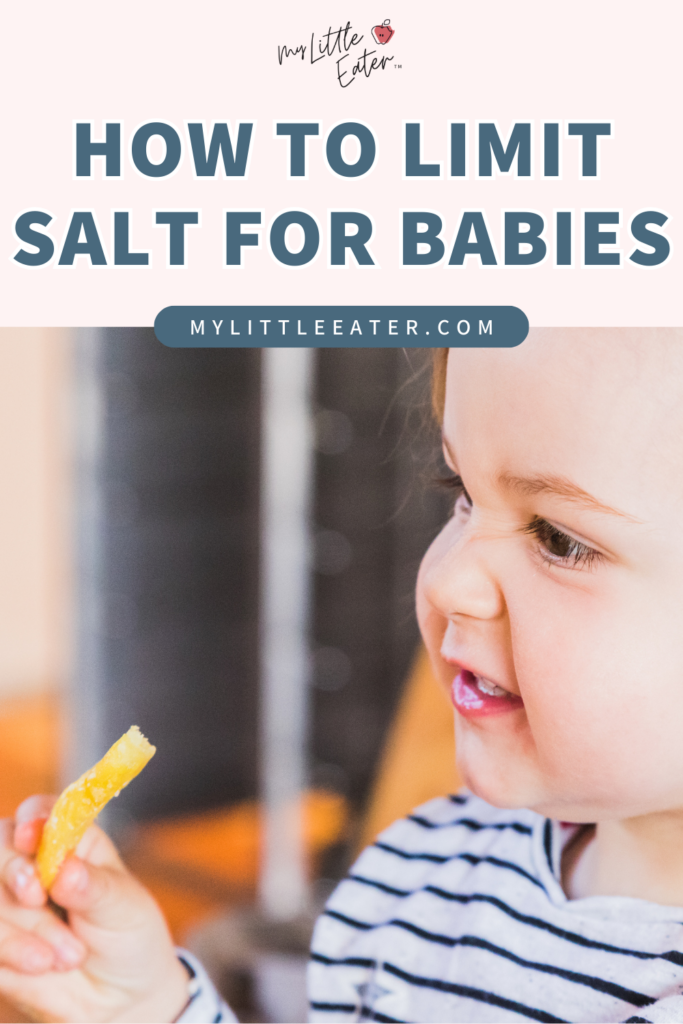
Table of Contents
Key Takeaways
Key Takeaways
- Avoid processed foods that are high in sodium.
- Choose “no-sodium-added” or “low-sodium” products when available.
- Cook homemade and eat at home more than you eat out.
- Set aside a salt-free portion of the dish for your baby before adding salt for the rest of the family.
- Use lots of salt-free seasonings.
- Think of how their sodium intake balances over the course of a week, not in a single day.
- Don’t track every mg!
Skip to our tips on how to limit sodium for babies!
Looking for low-sodium, dietitian-approved recipes for your baby? You’ll love our 60-Day Baby Led Feeding Meal Plan!
Our meal plan takes the stress out of deciding what meals to serve, and how to safely serve them to your baby. You can feel confident knowing that your baby is getting the exposure to new foods and textures that they need to prevent picky eating – with no extra planning or time wasted for you!

If you prefer to listen while you multitask, download the podcast episode below to learn all about sodium for babies!
Salt versus sodium
Let’s start by clearing something up…many people refer to salt and sodium interchangeably, but they’re not the same thing. Sodium is an essential mineral that’s naturally found in most foods in varying amounts (1). Salt, on the other hand, also known as table salt, is what we add to food. It’s made from a mixture of both sodium and chloride (1).
For context, there are about 400mg of sodium in 1 gram of table salt (2). So you can see how adding “just a pinch” of salt to your baby’s food could add up quickly.
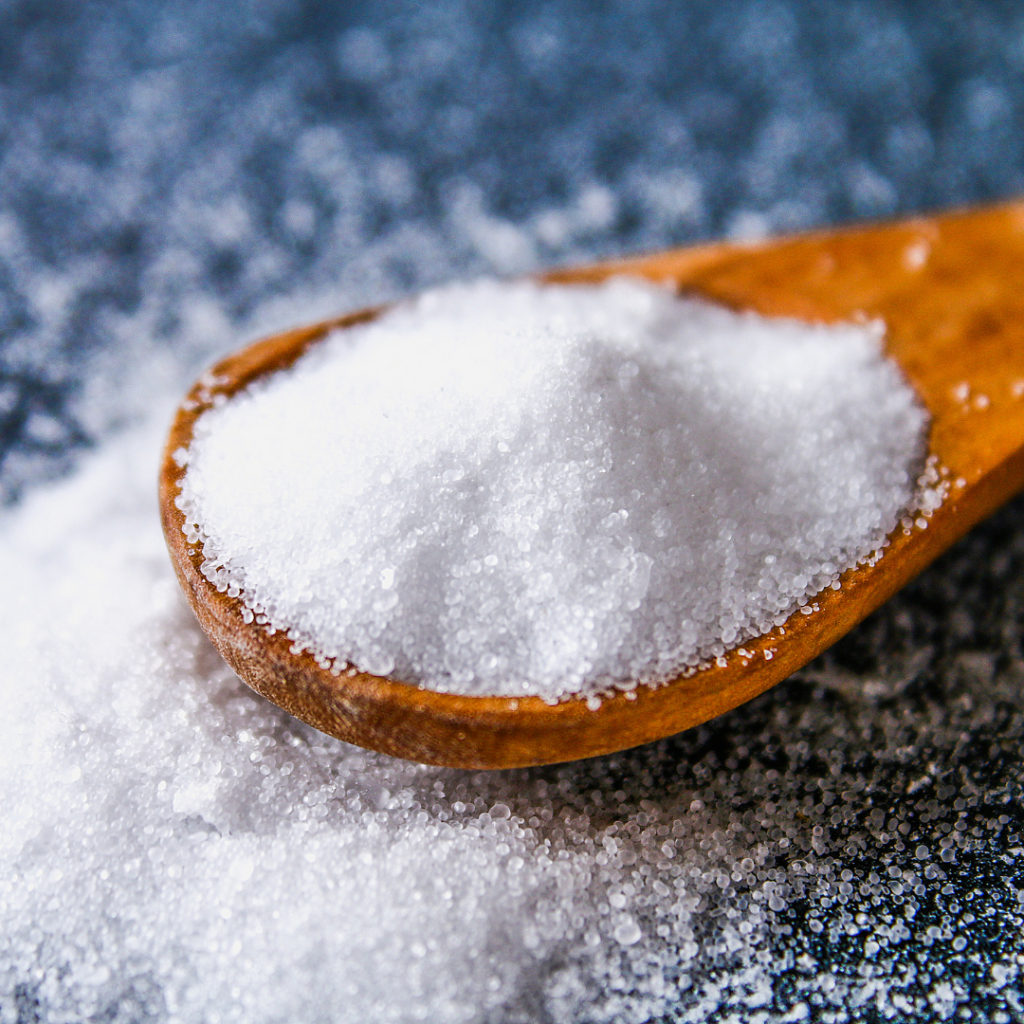
Sodium is what the recommendations are based on, not salt. So if you were truly going to count every mg of sodium your baby ate, you’d have to include fresh, whole foods that naturally contain sodium too – not just pre-made or processed foods!
Do babies need sodium?
Sodium is considered to be an essential nutrient in the body which means that it is needed for the body to function normally (3).
As an electrolyte, sodium is involved in several important processes in the body such as (4):
- Maintaining fluid balance
- Regulating blood pressure
- Regulating nerve and muscle function
Now, there’s no need to offer your baby high-sodium foods just because sodium is an essential nutrient. In general, offering a variety of healthy, whole foods will provide your baby with the small amount of sodium that they need.

As an example, here are some whole, healthy foods that contain some sodium (5-10):
- Beets (65.4mg per ½ cup, cooked and sliced)
- Sweet potato (36 mg in ½ cup, cooked)
- Carrots (38mg in ½ cup, raw and grated)
- Avocado (14.1mg in one medium-sized avocado)
- Cantaloupe (12.8mg per ½ cup, cubed)
- Apples (2.2mg in one large apple)
Sodium is also found in breast milk and formula, so babies do get some sodium from day 1 before they even start eating solid foods.
At what age can babies have salt?
We don’t recommend adding lots of table salt directly into your baby’s food or giving them food with a lot of added salt until they’re closer to 1 year old.
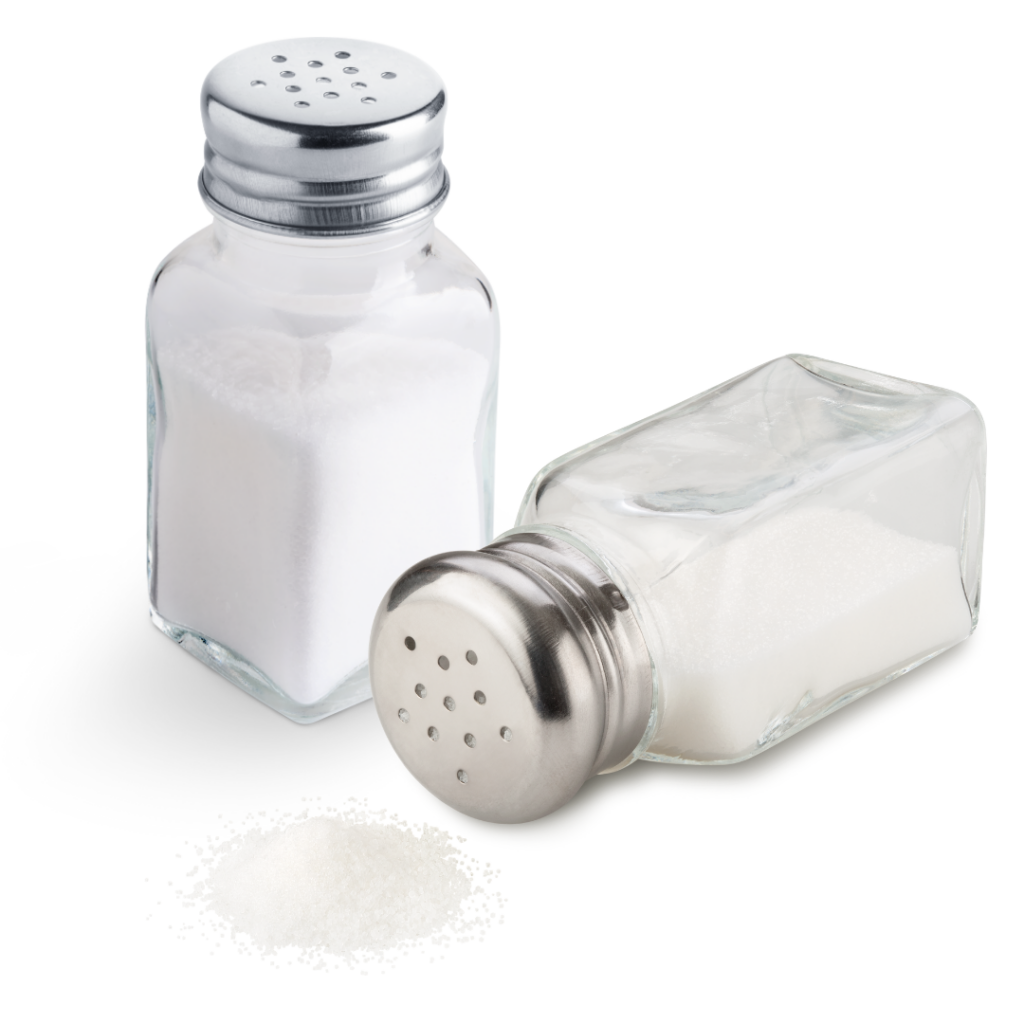
Just like how too much salt isn’t good for adults, too much salt isn’t healthy for babies either. Plus, their little bodies are so small that the amount of salt that’s ok for them is much lower than what’s acceptable for grown adults.
That said, if your baby has a bite of your homemade meal with a little bit of salt sprinkled on top, there’s no need to panic!
How much sodium is safe for babies (the current guidelines)
Most health guidelines, including the World Health Organization (WHO), recommend limiting sodium for babies in some capacity – whether that be by avoiding high-sodium foods or strictly avoiding adding any salt to your baby’s meals (11,12).
While there is no established daily limit for babies, there is what’s called an adequate intake (AI) for sodium. This is set at 370 mg per day for babies between 7-12 months. This amount includes sodium intake from both solid foods and milk (ie. breast milk or formula) (13).
If you’ve ever paid attention to sodium on a nutrition facts table, you’ll know that that’s a very small amount. For reference, just 2.5 oz of cheddar cheese has 457 mg of sodium (14)!
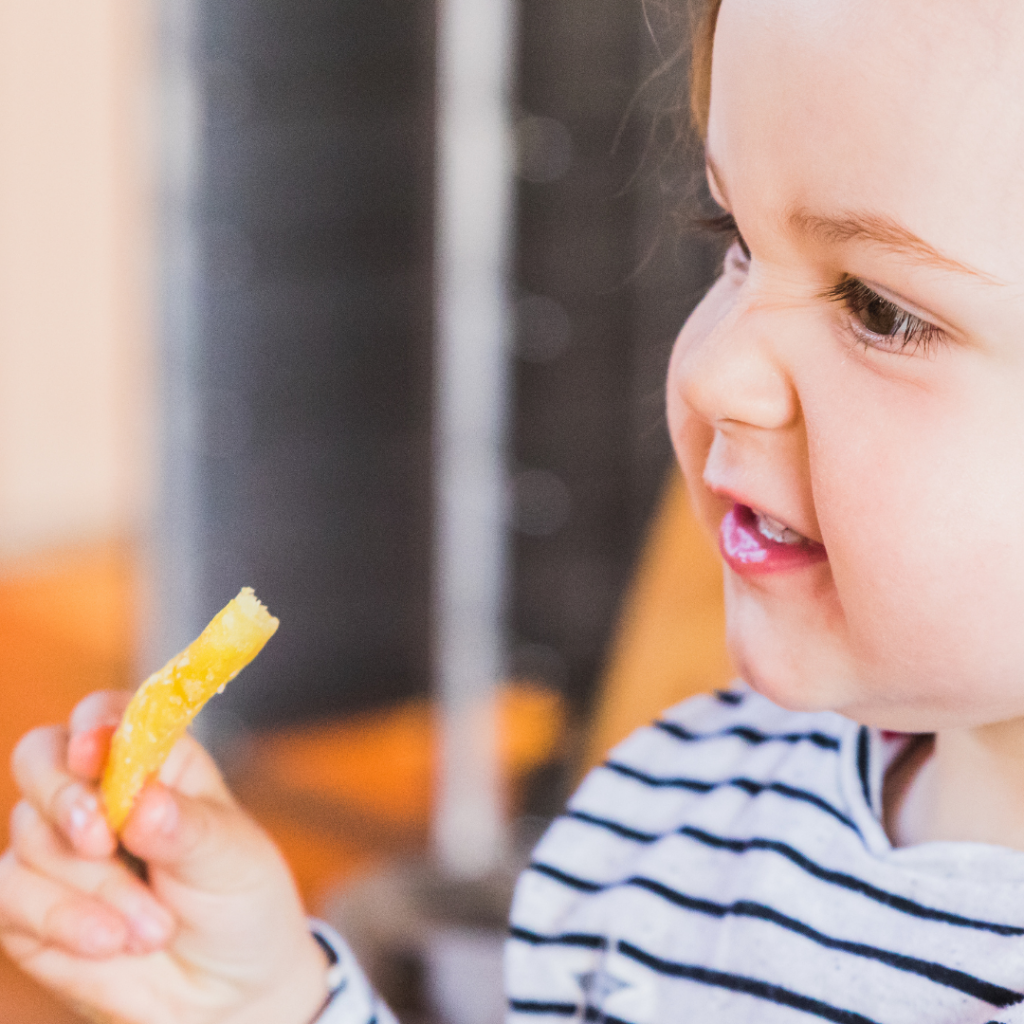
How the guidelines were created
You might be wondering how these guidelines were made, and why they’re so low.
It has to do with how dietary recommendations are created. Normally, research is done to establish what’s called an estimated average requirement (EAR) for each nutrient. The EAR represents the amount of a nutrient that is estimated to meet the needs of half of the individuals in a specific lifestage group (15).
Since it would be unethical to test the health effects of different sodium intakes on babies, we don’t have enough evidence to set an EAR. In cases like this, we have to rely on averages to establish an AI.
As a result, the AI of 370 mg of sodium per day was based on the average amount of sodium consumed by healthy babies between 7-12 months (16).
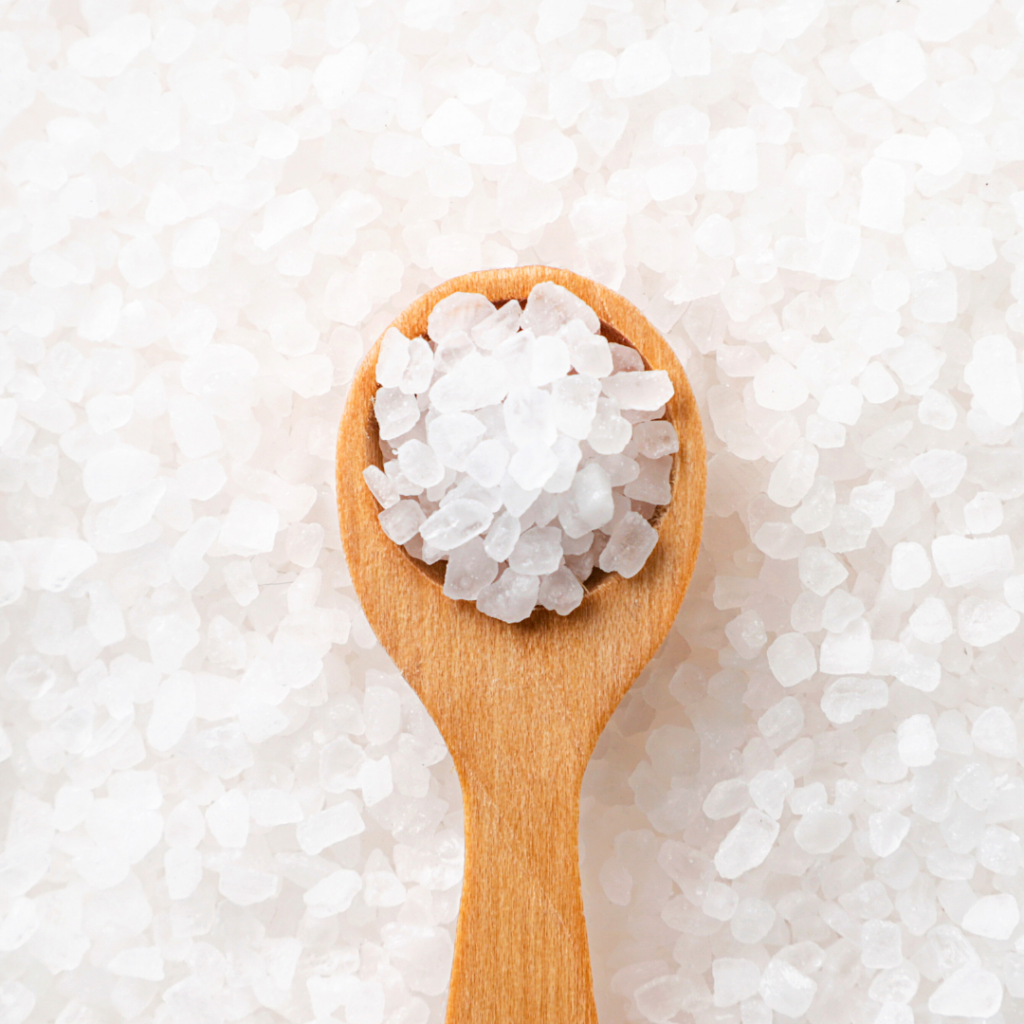
To dive a bit deeper, the 370 mg AI was created by adding together the sodium from an average intake of solid food with the average amount of sodium in 20 oz of breast milk (17).
Here’s the problem…the exact amount of nutrients in breast milk, including sodium, can vary greatly from person to person, day to day, and even from feeding to feeding (18,19).
More than that, the amount of milk feedings and solid foods that babies get per day, and the amount of breast milk or formula and solids that they consume at each feeding opportunity, can vary a lot too.
So to say that anything over “x” amount of sodium from solids per day is dangerous for babies is simply not justified.
In a nutshell, the 370 mg of sodium AI is an estimate for the amount of sodium that’s healthy for your baby, not a maximum.
My Little Eater
Recommendation
Recommendation
We believe that it’s not worth stressing yourself out counting every single milligram of sodium that your baby consumes. However, it is still important to limit sodium for babies where possible.
Focus on the things that are within your control such as not adding salt directly to your baby’s food, avoiding high-sodium processed foods, and cooking meals from home most often.
If you do these three things, then there’s no reason to stress over your baby eating out at a restaurant once in a blue moon or having a pre-made meal on a busy night – just go back to serving low-sodium food the next day.
Trust that your baby’s overall sodium intake will balance out by thinking about your baby’s intake as a weekly average rather than a strict daily limit.
Keep reading for more details on how we came to this recommendation and the research behind it.
7 simple ways to limit sodium intake for babies
Here’s how you can limit sodium for your baby without keeping track of every mg they eat every. single. day. It’s actually a lot easier than you might think!
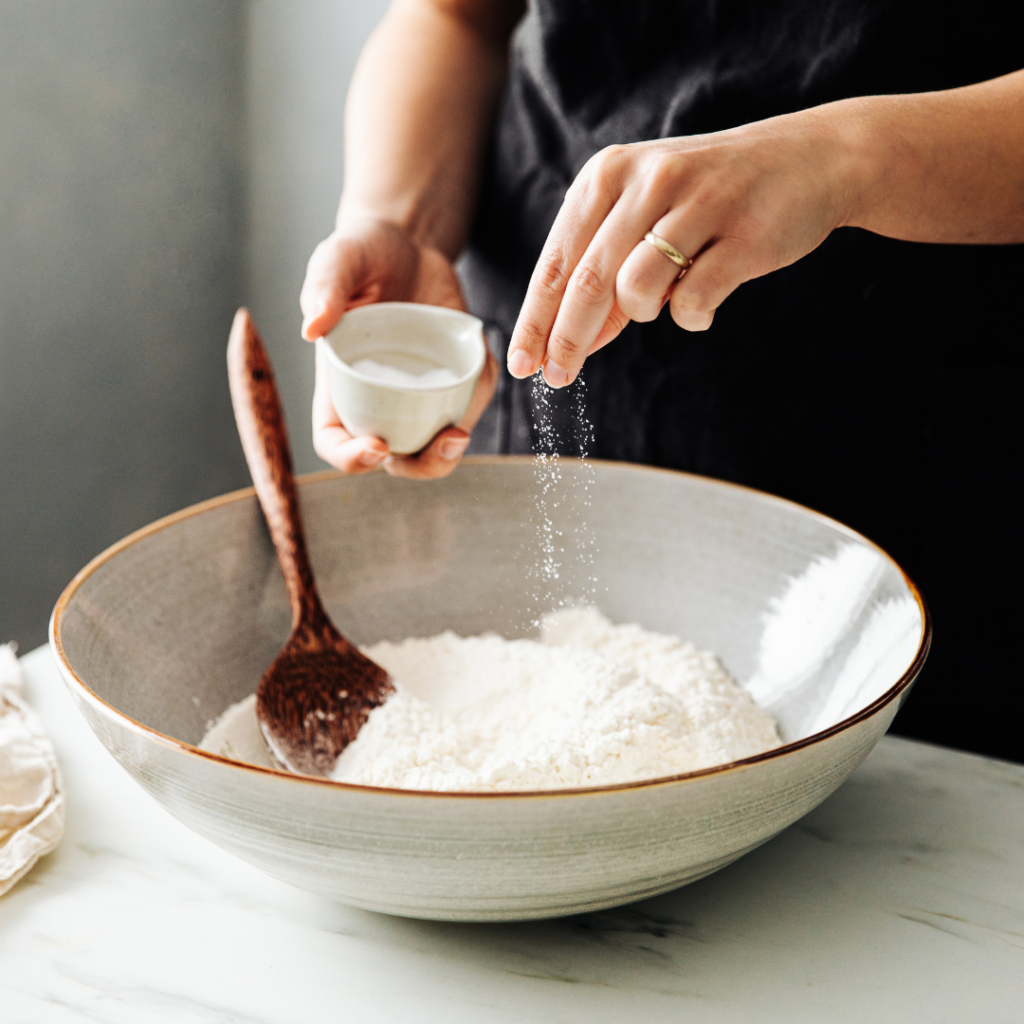
1. Avoid processed foods that are high in sodium
Using the salt shaker at home can contribute to high sodium intake, but really, the salt shaker isn’t the main culprit. Most of our sodium intake (over 70%) actually comes from the consumption of packaged and processed foods (20).
Limiting processed foods and focusing on offering whole, unprocessed foods instead is the number one thing that will help to naturally limit sodium intake.
Some of the most common processed food culprits contributing to high sodium intake in babies are canned soup, mixed pasta dishes (ie. packaged pasta, frozen lasagna, etc.), and sausages (21).
Other high-sodium foods include (22):
- Processed meats (burger patties, deli meats, bacon, and ham)
- Salty snacks (chips, crackers, and pretzels)
- Premade frozen foods (such as chicken nuggets, and pizza)
- Sauces and condiments (gravies, tomato sauce, BBQ sauce, Worcestershire sauce, ketchup, and soy sauce)
- Store-bought spice blends
- Canned or pickled vegetables (olives, pickles, etc.)
- Cereal (that is not made specifically for babies)
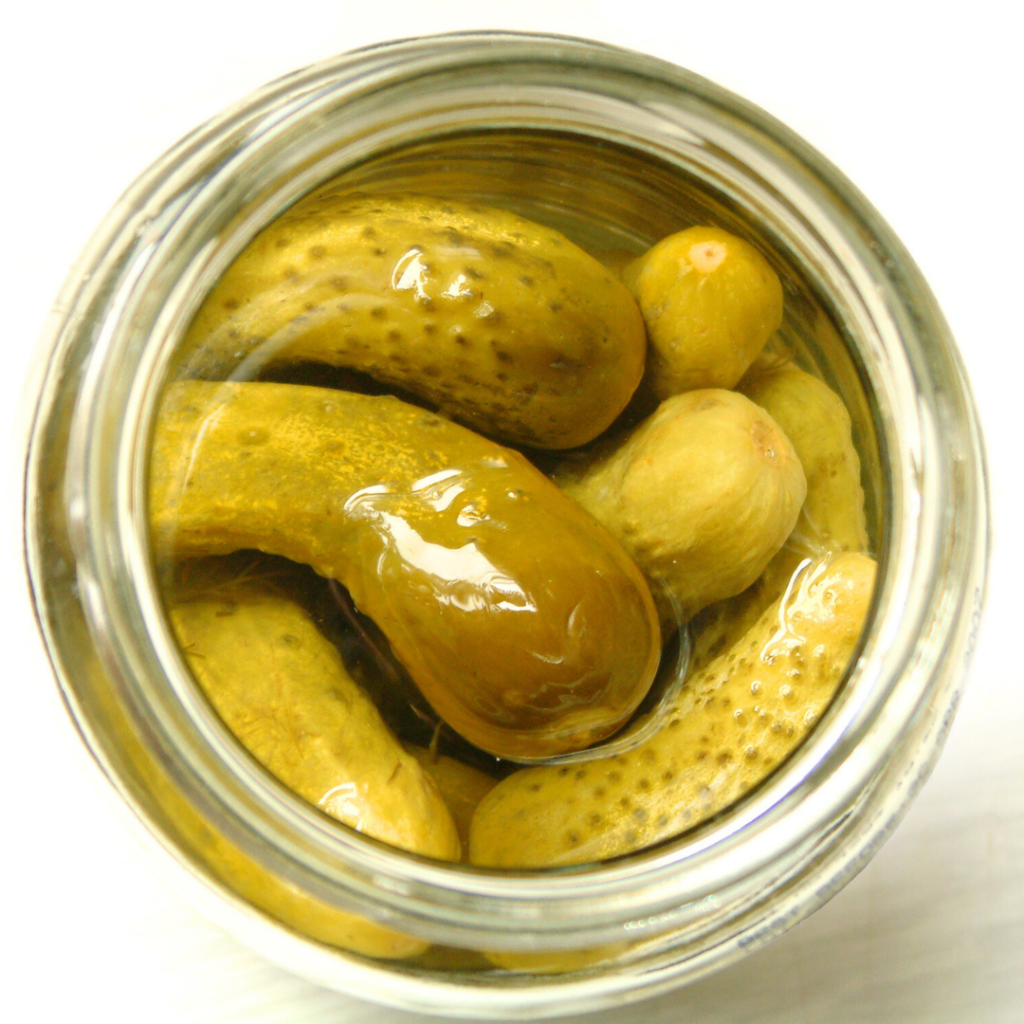
Let’s give an honorable mention to foods that we don’t typically think of as processed, but that usually contain a significant amount of sodium…bread and cheese. This includes all baked goods such as tortillas, muffins, bagels, and various types of bread, plus all cheeses, especially parmesan, Roquefort, gouda, camembert, blue cheese, and feta cheese.
Important Note!
Important Note!
There are some foods that are high in sodium that, in our opinion, are worth including in your baby’s diet once in a while. These foods include things like feta cheese, olives, sauerkraut, sardines, and miso. Introducing your baby to these strong flavors can help your baby learn to like these foods, which despite being high in sodium, are nutritious additions to a balanced diet.
When you choose to offer these foods, just balance them out with other lower sodium foods within that meal and throughout the day (or the following day).
2. Choose “no-sodium-added” or “low-sodium” products when available
If the list of processed foods above freaked you out, please don’t stress!
We’re not saying that you can never serve the processed foods listed above to your baby – that’s just not realistic. Instead, we propose that you make some simple swaps to limit your baby’s sodium intake for those times when cooking from scratch isn’t an option. You can do this by swapping the product you would regularly buy with a “no-sodium added” or “low sodium” option.
This is especially important for foods that you may serve regularly like breads, meats, dairy products, and canned foods (ie. canned soups, broths, meats, legumes, vegetables, and sauces).
My Little Eater’s favorite swaps
Food for Life Low-Sodium Sprouted Bread
It has 3 grams of fiber, 5 grams of protein, and most impressively, 0mg of sodium per slice!
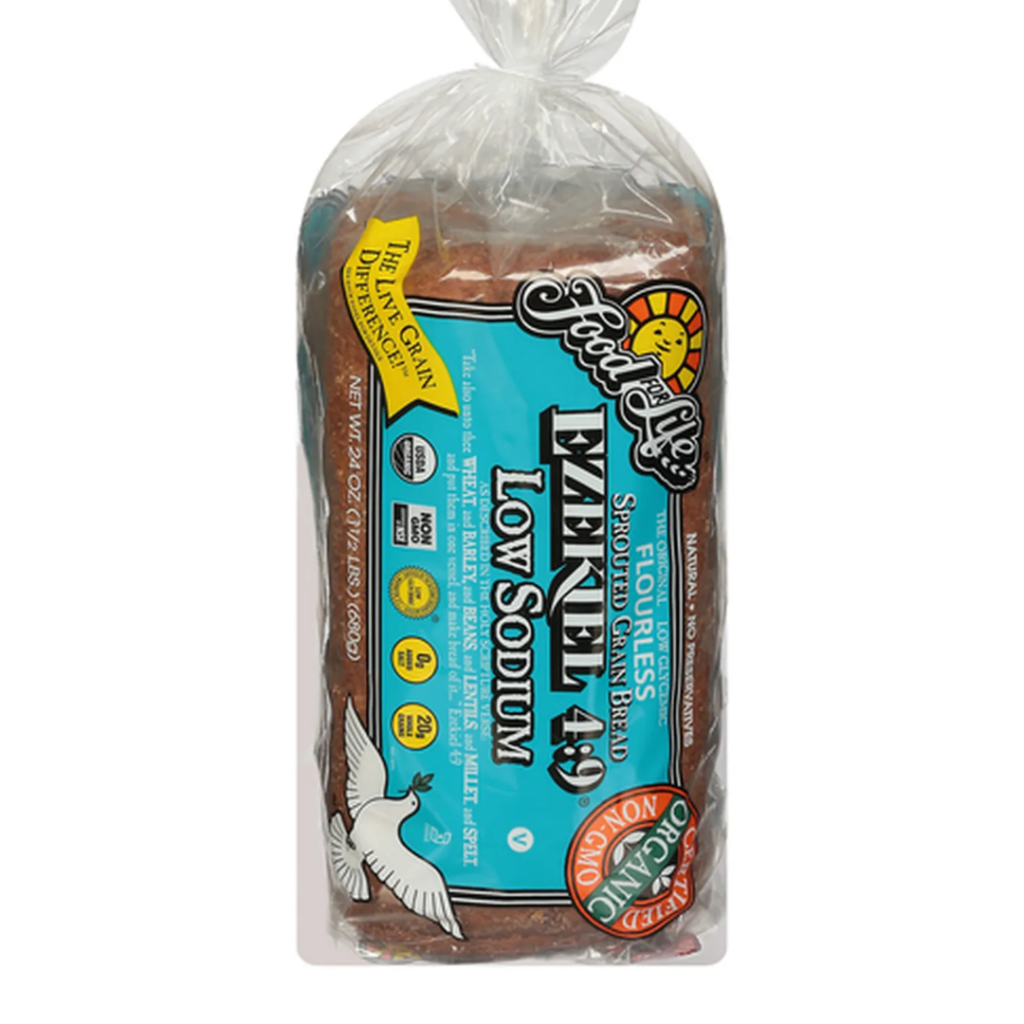
Food for Life Low-Sodium Sprouted Bread
It has 3 grams of fiber, 5 grams of protein, and most impressively, 0mg of sodium per slice!

Eden Organic’s No-Salt Added Spaghetti Sauce
This tomato sauce is made with healthy, whole-food ingredients, and has only 25mg of sodium per ½ cup serving (compared to traditional canned spaghetti sauce which has over 500mg per ½ cup).
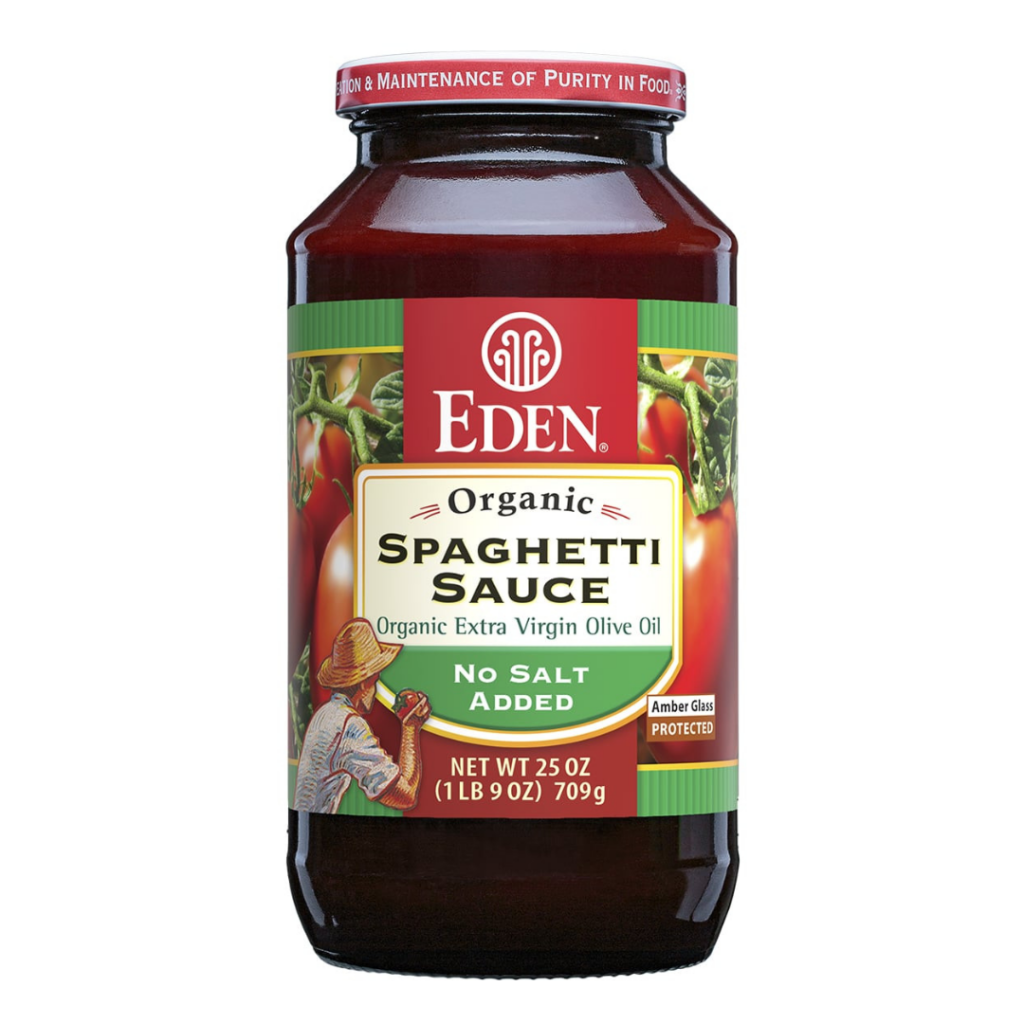
Eden Organic’s No-Salt Added Spaghetti Sauce
This tomato sauce is made with healthy, whole-food ingredients, and has only 25mg of sodium per ½ cup serving (compared to traditional canned spaghetti sauce which has over 500mg per ½ cup).

Wild Planet No-Salt Added Wild Sardines
These low-sodium sardines are packed in water, and have no added salt. They have only 70mg of sodium per 3 oz serving compared to salted canned sardines which typically have 170mg. Some flavored varieties of canned sardines have even more sodium than this, with over 400mg per 3oz serving!
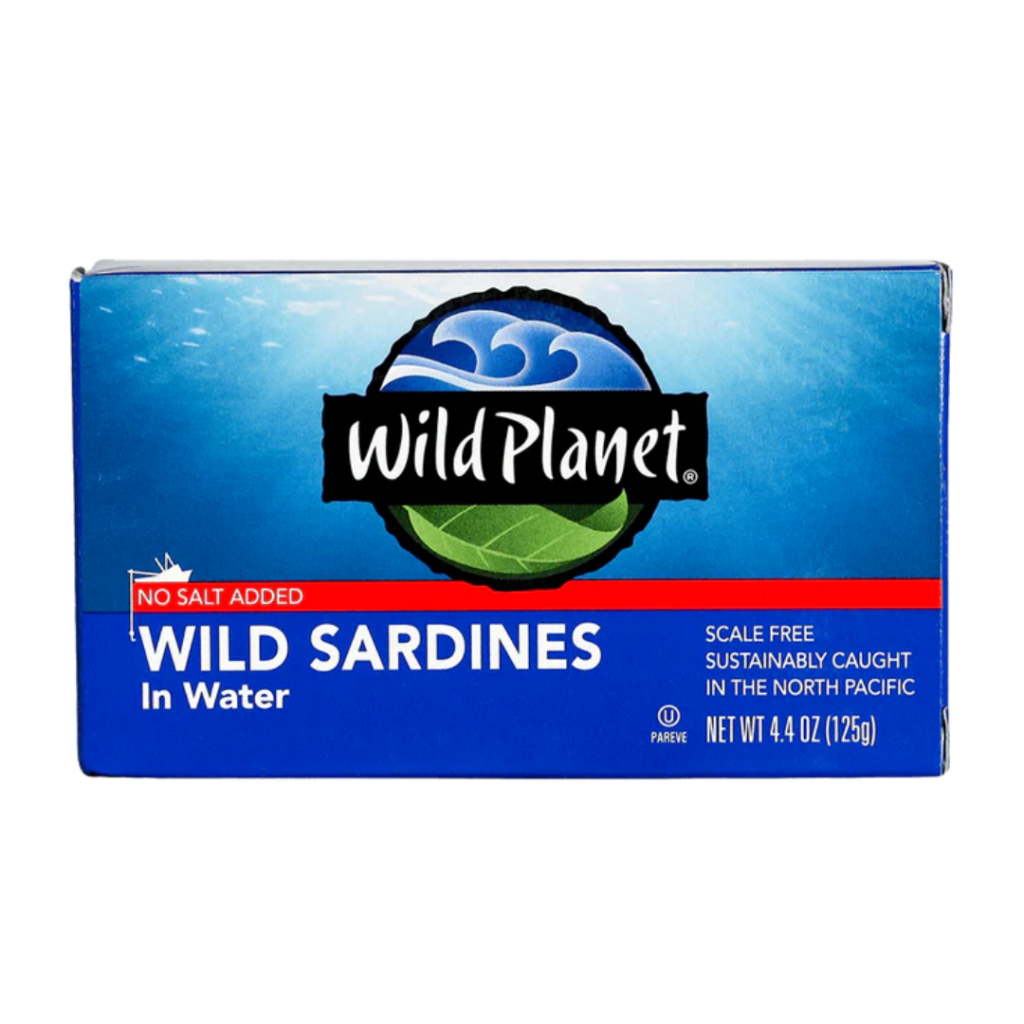
Wild Planet No-Salt Added Wild Sardines
These low-sodium sardines are packed in water, and have no added salt. They have only 70mg of sodium per 3 oz serving compared to salted canned sardines which typically have 170mg. Some flavored varieties of canned sardines have even more sodium than this, with over 400mg per 3oz serving!

Low-sodium cheeses
Cheese is generally higher in sodium, but certain varieties like parmesan, Roquefort, gouda, camembert, blue cheese, and feta cheese are especially high. Swap out these cheeses for lower sodium options if serving it more regularly (the occasional taste of a higher sodium option is fine, as mentioned above).
Some lower sodium options are Swiss, ricotta, goat cheese, no-sodium-added cottage cheese or low-sodium mozzarella.
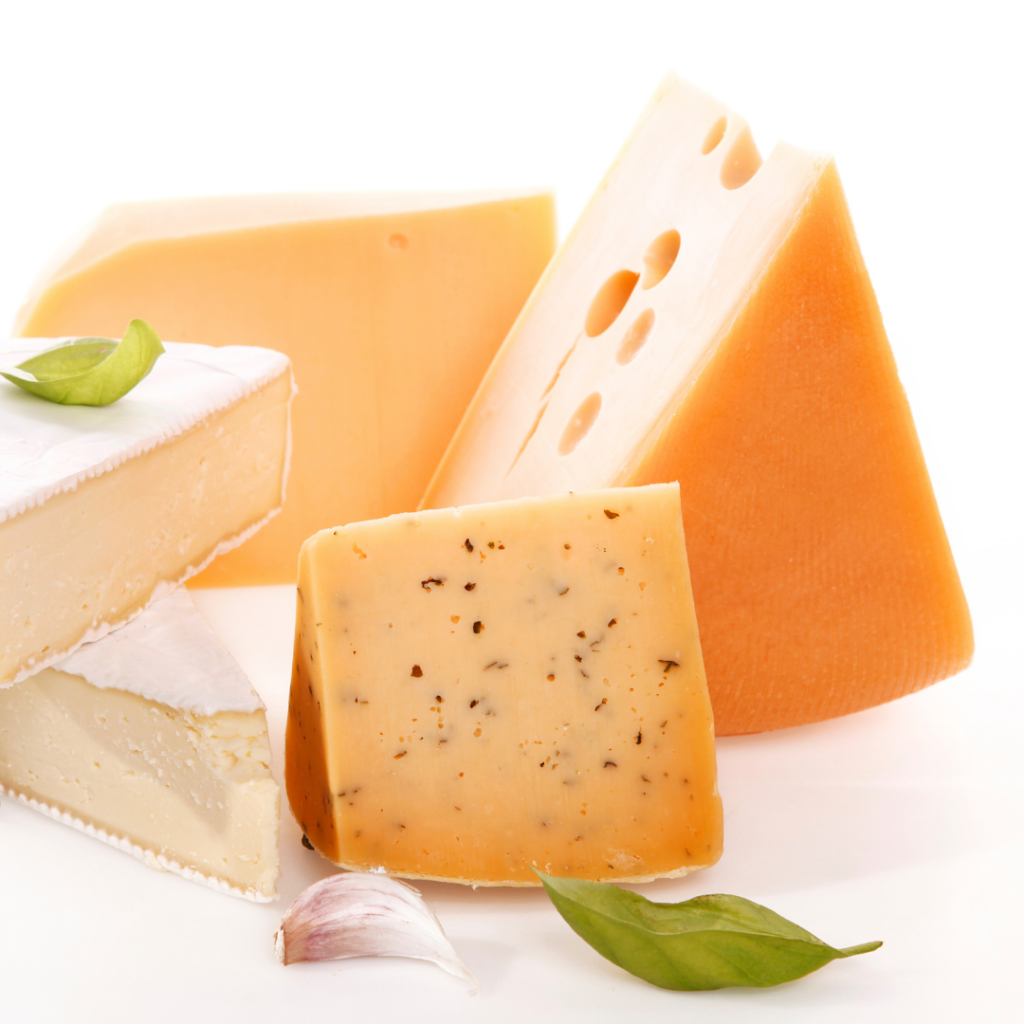
One word of caution when it comes to mozzarella…while fresh mozzarella is low in sodium, it’s not always pasteurized. Make sure that any cheese you’re buying for your baby is pasteurized, as unpasteurized foods pose a risk for babies because of their underdeveloped immune systems (23).
3. Rinse canned or pickled foods under cold water
If no-sodium-added versions aren’t available and you’re in a pinch, you can rinse canned foods (like canned beans, lentils, chickpeas, sardines) or pickled vegetables under cold water and then drain them to remove excess sodium.
4. Make it homemade
We understand that this is easier said than done and that you likely don’t have a ton of free time as a parent to experiment in the kitchen. That said, if you struggle to find a product that you and your family enjoy that’s also lower in sodium, it can sometimes be worth making it from scratch!
We recommend aiming to make things like soups, sauces, pancakes, and muffins from home when time permits. Again, please go easy on yourself if this isn’t possible for you right now.

5. Decrease the frequency of restaurant meals
We know that life with a baby is busy (that’s the understatement of the year), and cooking takes time! But the reality is that restaurants use far more salt than we ever would at home.
It’s important that home-cooked meals made from whole foods make up the majority of your baby’s diet. Not only will this give them the nutrients they need to grow and thrive, but it will also reduce the amount of sodium that your baby is taking in.
We’re not saying that you can never take your baby out to eat with you. But if you go out to eat at a restaurant one day, you’ll want to be conscious of offering less sodium the next day to balance things out.
One meal out doesn’t make a big difference long-term – what’s most important is what you do most often.
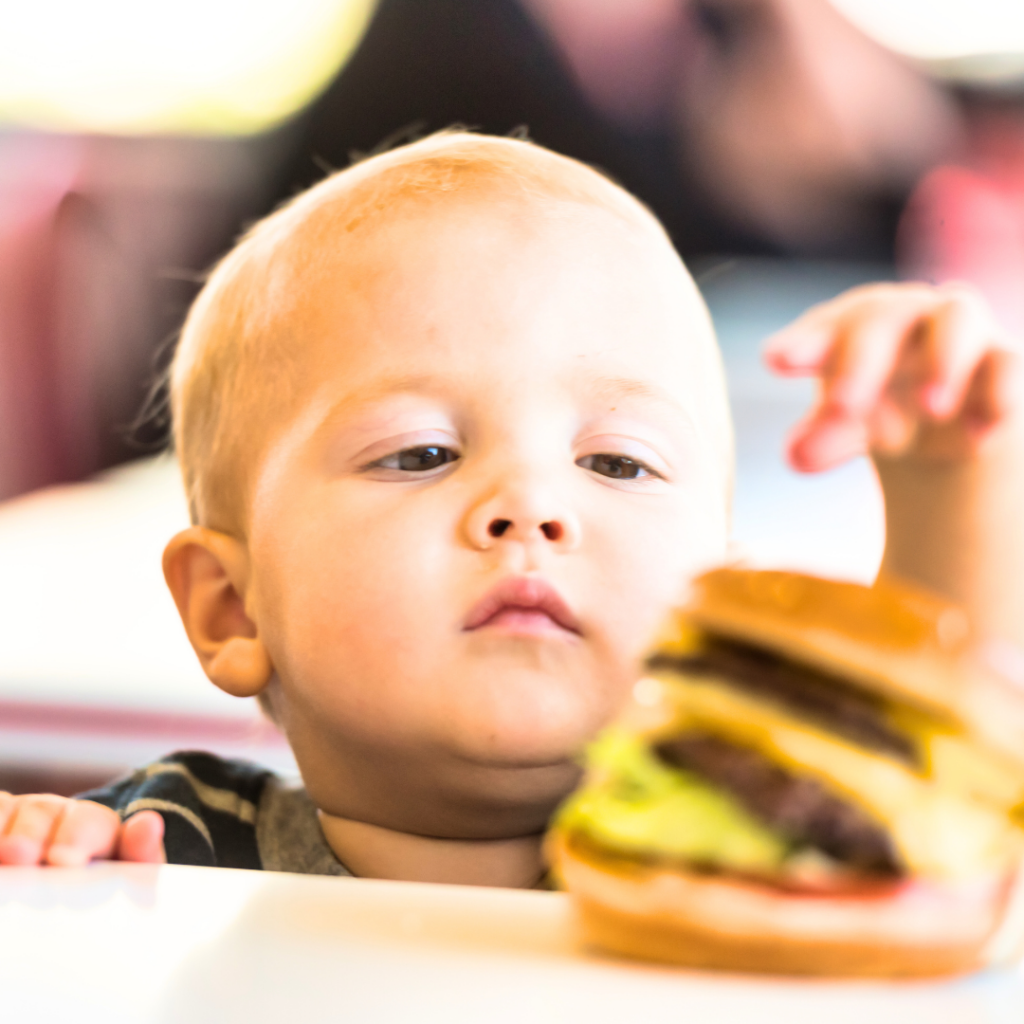
6. Set aside a salt-free portion of food for your baby
First, let’s clear something up. If you add a little bit of salt to a big batch of a family meal – that’s ok! We always prefer that your baby enjoy food from your family meal instead of cooking two entirely separate meals.
However, sometimes you might find yourself wanting to make a specific recipe for your family that has a bit more salt in it. All you have to do in this case is set aside a portion of the recipe for your baby before you add the salt for the rest of the family!
7. Use lots of salt-free seasonings
Using less salt doesn’t have to mean bland food for your baby! We encourage you to add salt-free seasonings, herbs, and spices to your baby’s food to expose them to a variety of new flavors!
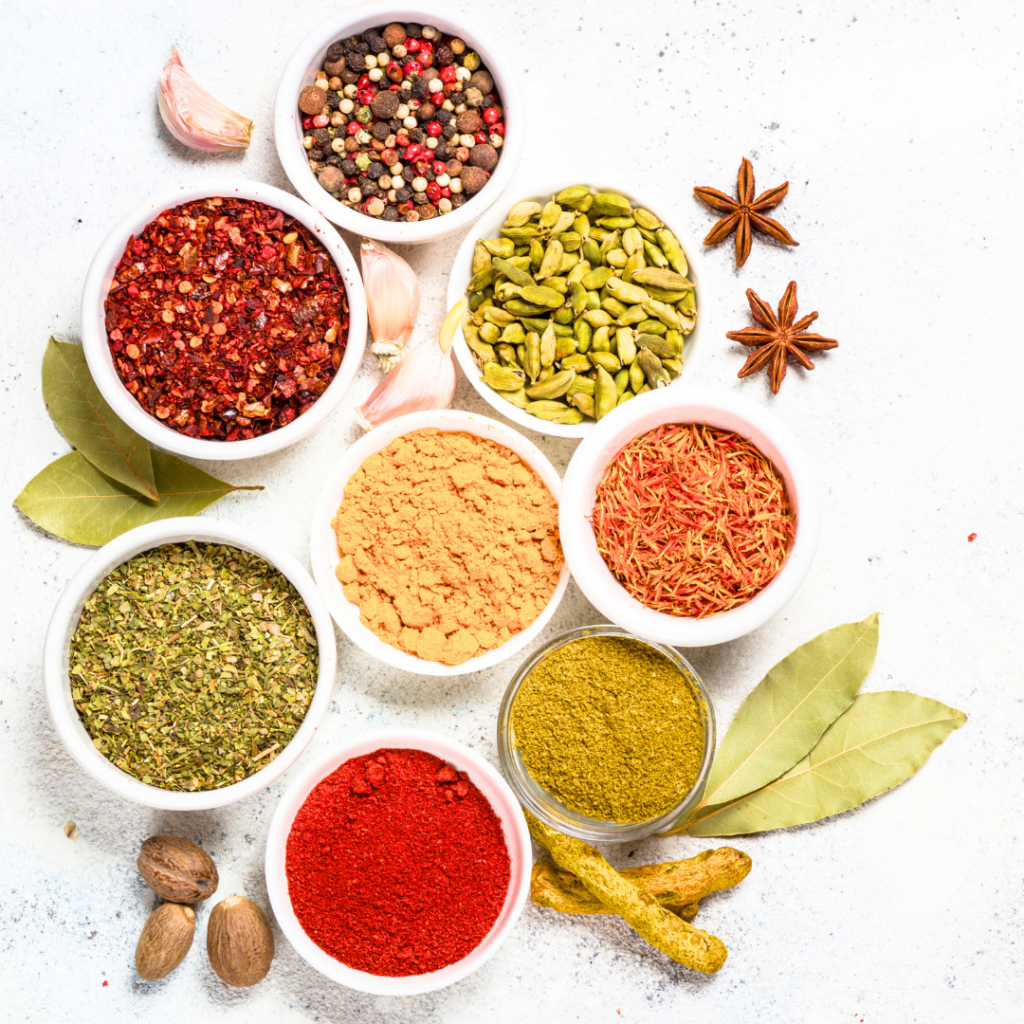
Here are some flavor combinations to help you get started:
- Lemon juice and dill on fish
- Garlic (or garlic powder) and onion mixed into mashed potatoes
- Rosemary or thyme on beef
- Nutritional yeast mixed into mashed avocado
- Zaatar or chopped mint mixed into yogurt
- Turmeric or chopped cilantro mixed into rice
- Curry powder on roasted carrots
- Paprika on potato wedges
- Pepper in scrambled eggs
- Cumin on roasted cauliflower
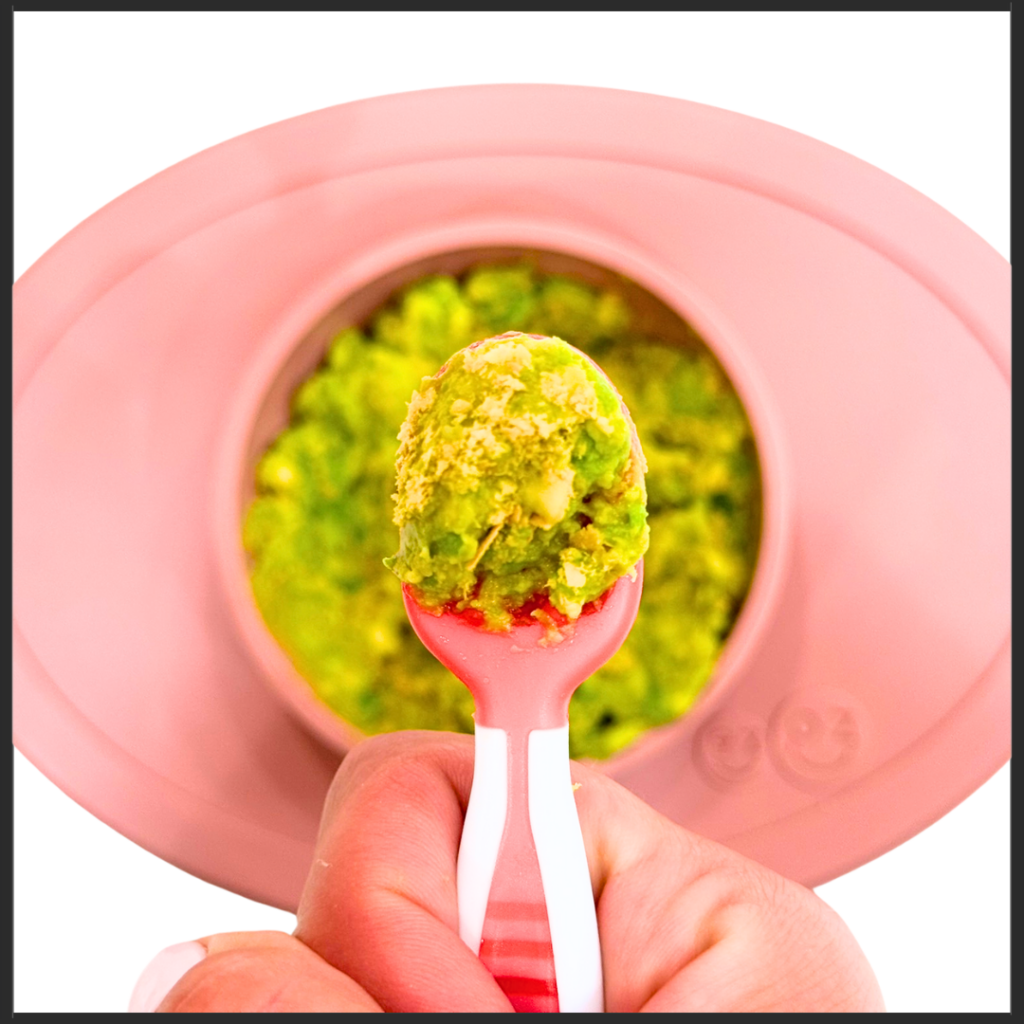
Here are some flavor combinations to help you get started:
- Lemon juice and dill on fish
- Garlic (or garlic powder) and onion mixed into mashed potatoes
- Rosemary or thyme on beef
- Nutritional yeast mixed into mashed avocado
- Zaatar or chopped mint mixed into yogurt
- Turmeric or chopped cilantro mixed into rice
- Curry powder on roasted carrots
- Paprika on potato wedges
- Pepper in scrambled eggs
- Cumin on roasted cauliflower

Myths about salt for babies
You may have already heard some scary reasons why babies shouldn’t have any salt, but is there any validity to these statements? Allow us to put your mind at ease and debunk the most common myths.
Myth #1: Salt can harm developing kidneys
Despite how commonly this is said, there’s surprisingly very little research to support this claim. While it is true that babies have smaller kidneys compared to adults, there’s no reason to suggest that their capacity to filter out sodium is reduced (24). An exception to this is of course babies with kidney disease or kidney dysfunction.

Babies born with low birth weight may also have reduced kidney function, making them more sensitive to sodium. However, a healthy baby with healthy kidneys is fully capable of handling sodium. To say that any amount of salt will damage your baby’s kidneys simply is not true (25).
Myth #2: Salt can predispose babies to high blood pressure
There’s just not enough evidence to support this claim either!
This claim came from a study done in 1983 in the Netherlands where one group of babies was given a “high-sodium” formula and another group was given a “low-sodium” formula. Both groups were told to introduce solid food along with the formula (26).
After 15 years, some of the children were assessed again, and it was found that those from the “high-sodium” group had slightly higher blood pressure than those from the “low-sodium” group (27).
If we dig deeper, several flaws with this study make their results questionable, to say the least.
First off, the babies were only 3 months old at the beginning of this study – way too young to be starting solids! Additionally, it has been suggested that babies may be less efficient at excreting sodium before the age of 4 months (28). This makes it hard to compare this to the effects of sodium after 6 months of age which is the appropriate time to start solids.

Secondly, only some (less than half) of the participants were followed up with 15 years later. So the findings can’t be generalized to a broader population.
Finally, while those who got a follow-up from the high-sodium group had slightly higher blood pressure by age the difference was not “statistically significant” (27). This means that the difference was not large enough to make a definitive conclusion.
To summarize, there’s just not enough evidence to suggest that salt early on in life predisposes babies to high blood pressure later in life (24).
Myth #3: Eating salt will cause hypernatremia in babies
A common fear is that babies will experience hypernatremia – AKA high levels of sodium in the blood – if they eat too much sodium. However, the reality is that low levels of sodium in the blood tend to be more common in babies, especially in those who are born prematurely (29).

When high sodium levels occur in babies, it’s most commonly related to dehydration (from things like diarrhea or inadequate breast milk or formula intake), not high salt intake (30,31).
Both low and high sodium levels in the blood are considered to be a medical emergency and require immediate medical attention.
Myth #4: Salt early on will increase cravings for salty foods later in life
A single exposure to salted food won’t be the thing that makes your little one crave salt later in life, but there is a little bit of truth to this one…let us explain.
Humans generally have a preference for salty foods as an evolutionary part of our biology to survive (32). But we also have to consider nature versus nurture. If your child is continuously offered highly palatable salty foods, they may be more likely to develop a preference for these foods because it’s what they’re used to (32).
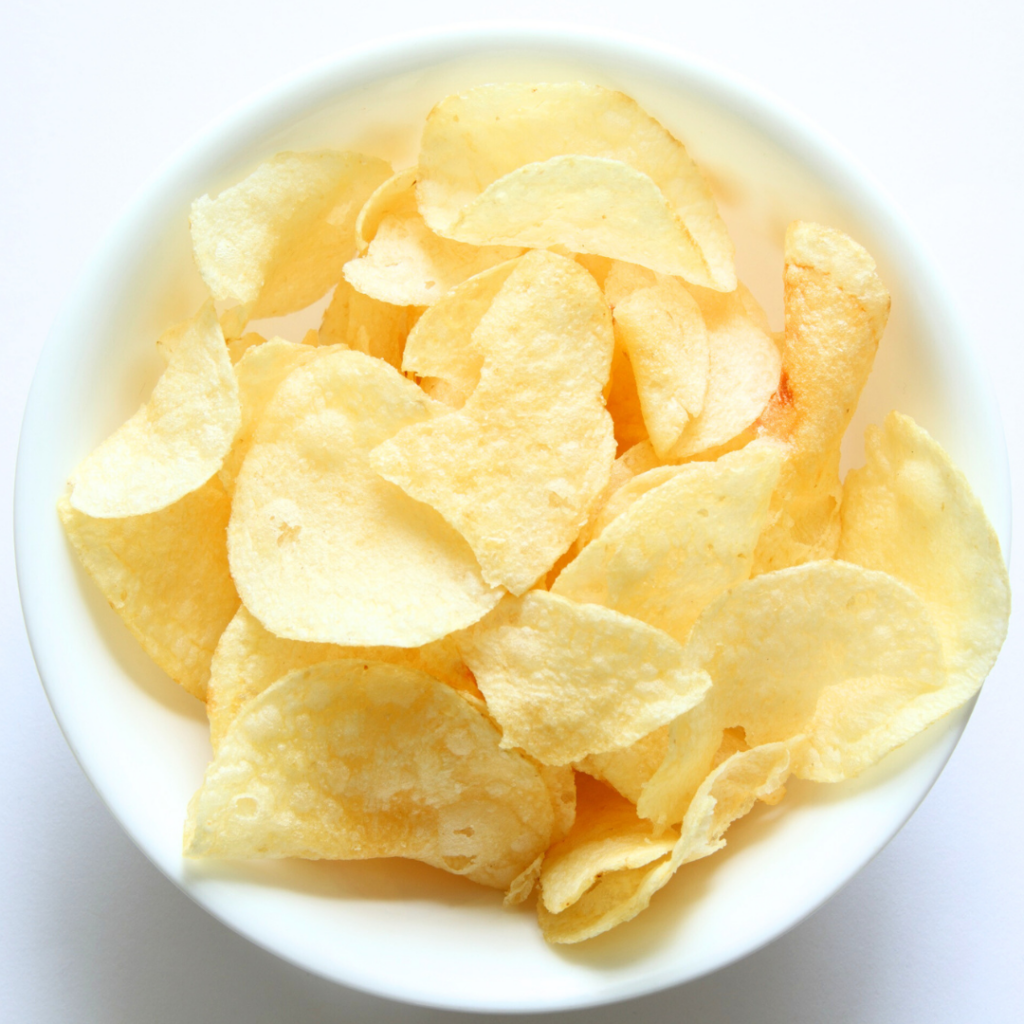
The same thing goes the opposite way – if you continuously offer your baby a wide variety of different healthy foods and flavors (other than salty ones), you can help them develop a preference for those healthy foods instead! This is a really important step in helping to prevent picky eating down the road.
Essentially, it comes down to frequency. This is why we recommend looking at balancing their sodium intake over the course of a week to ensure they aren’t having day after day of high-sodium meals.
Long story short, sodium isn’t all bad – our bodies do need some sodium from food in order to function normally. But in our modern society, we tend to eat too many processed foods that are high in sodium, and this is where the problem lies.
As we’ve said, it’s all about balance. Eating either too much or not enough sodium can have negative health consequences (33).
Salt FAQs
Can I give pink salt to my baby?
Himalayan pink salt has gained a fair bit of popularity in recent years and is often viewed as a healthier alternative to table salt. But the truth is…the differences are negligible.
While pink salt does contain slightly higher levels of essential minerals like calcium, iron, magnesium, and potassium, the amount of pink salt your baby would need to consume to get any significant amount of these minerals would certainly not be healthy.
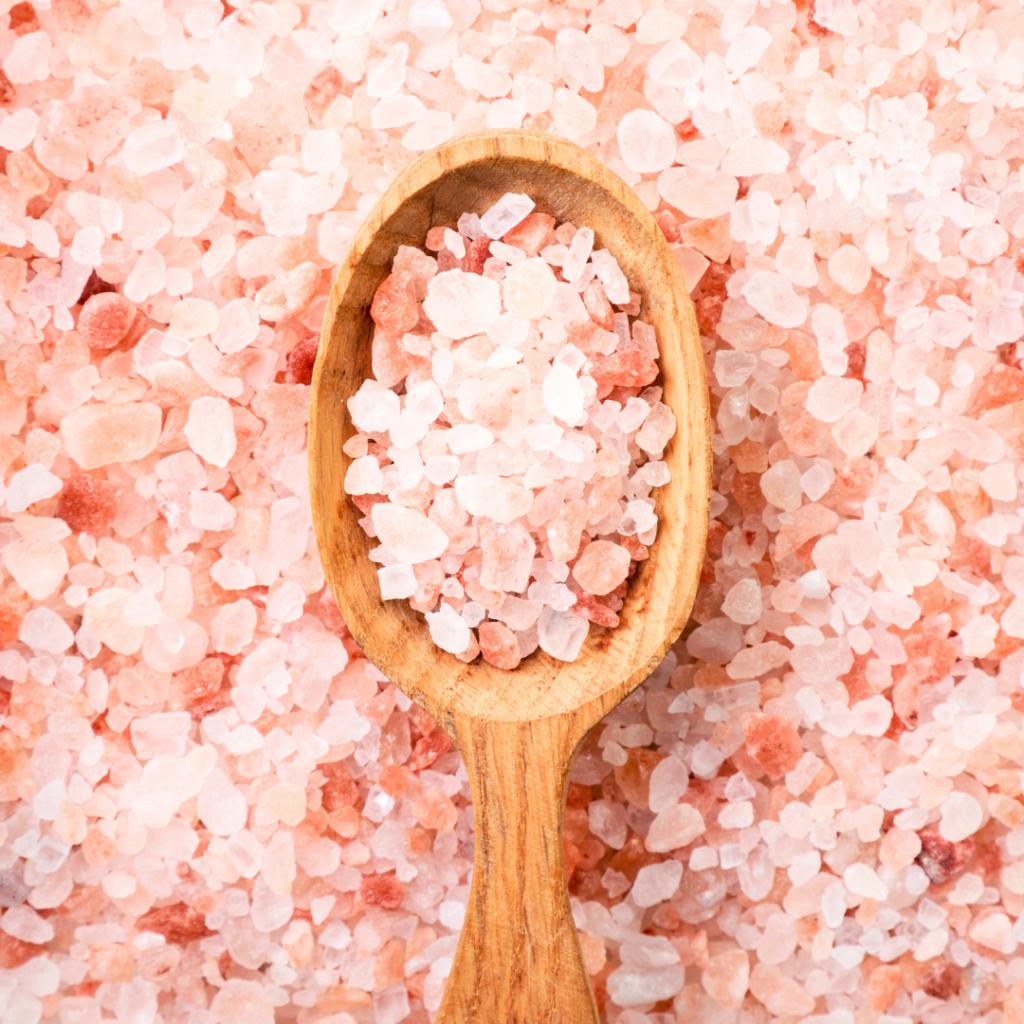
To put this into context, to get the daily recommended amount of calcium (260 mg) from pink salt, a baby would need to consume on average 100 grams of pure pink salt (34). That’s close to ⅓ of a cup of salt!
The negative side effects of such a high amount of sodium would far outweigh any benefits the minerals would have on your baby’s health (35). Plus, pink salt contains nearly the same amount of sodium per serving anyway. We’re talking only around 30mg of difference per 1 gram of salt (35).
The bottom line is that whether your family chooses to use table salt or pink salt, the same guidelines apply – both should be limited for babies.
What happens if my baby has a little salt?
Let’s say you’re actively limiting salt in your baby’s diet, and someone gives them a bite of one of the high-sodium foods listed above. Frustrating? Totally. But not the end of the world.
A bite or two of a high-sodium food won’t be harmful to your baby in the grand scheme of things. It’s more the daily practices that will make a difference. Focus on what’s within your control and do your best to limit sodium where you can.
Can I add a pinch of salt to baby food?
While it’s not the end of the world for your baby to consume a bite of food with a pinch of salt here and there, it’s not recommended to add salt directly to your baby’s food until they’re closer to 1 year of age. It’s just not necessary for them.
If you’d like to add a bit of flavor to their meal, you can (and should) add spices to their meals to broaden their palate and expose them to new flavors!
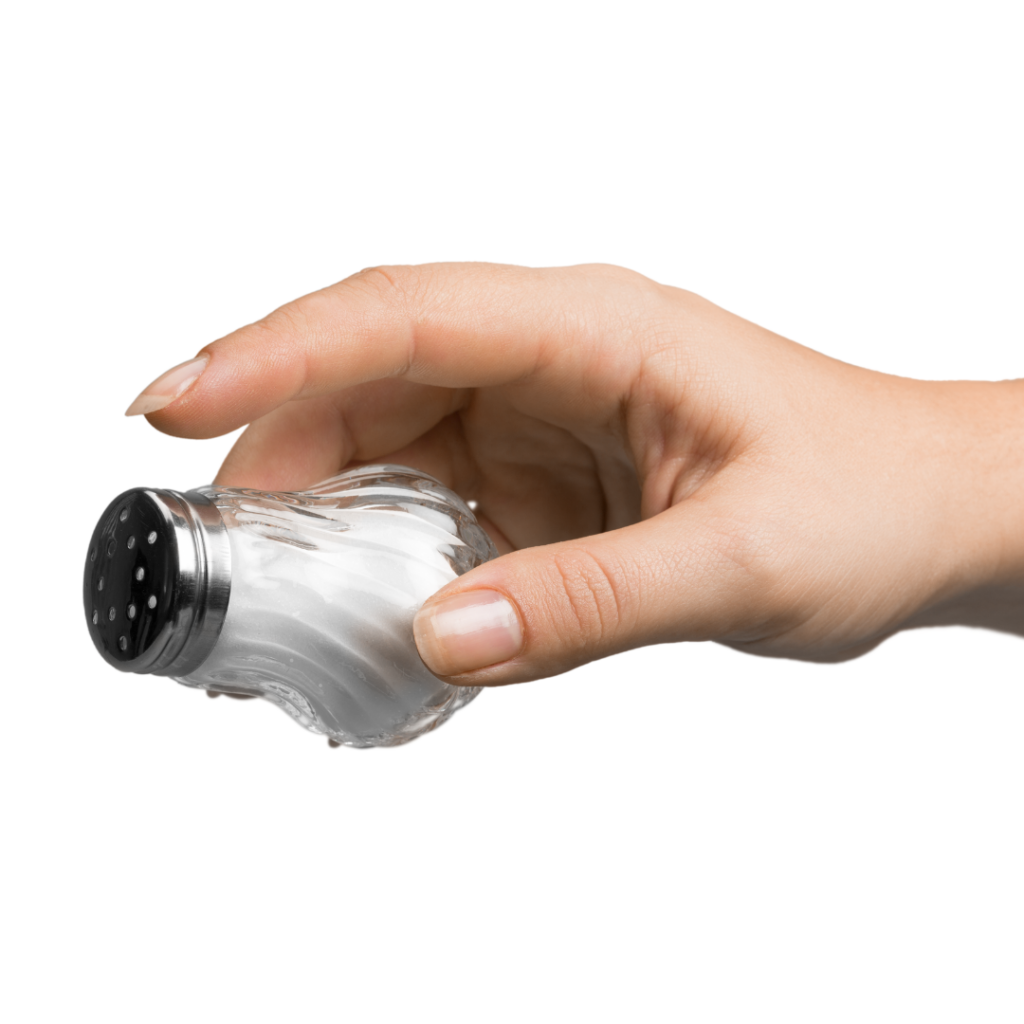
Can babies have baking soda?
As a short answer, yes. Most baked goods like bread and muffins contain baking soda as a leavening agent and your baby can safely eat foods that contain it.
However, it is worth keeping in mind that baking soda is a significant source of sodium. Baking soda is also known as “sodium bicarbonate” – keyword, sodium.
Just ½ tsp of baking soda (the standard amount used in most recipes) contains 630 mg of sodium (36). That said, this amount is typically used in a recipe that makes multiple servings.
Muffins that use baking soda, for example, usually make a count of 12, meaning that each muffin would only contain 52.5 mg of sodium. This amount is perfectly acceptable within the context of a varied diet composed mainly of whole foods.

To summarize, in the context of a healthy, varied diet, a little bit of salt is not worth stressing over. Limit sodium in your baby’s diet by focusing on what’s within your control. Cook from home as much as possible, do your best to limit processed foods, and don’t be too hard on yourself!
Looking for low-sodium, dietitian-approved recipes for your baby? You’ll love our 60-Day Baby Led Feeding Meal Plan. Our meal plan takes the stress out of deciding what meals to serve, and how to safely serve them to your baby.
You can feel confident knowing that your baby is getting the exposure to new foods and textures that they need to prevent picky eating – with no extra planning or time wasted for you!

Looking for low-sodium, dietitian-approved recipes for your baby? You’ll love our 60-Day Baby Led Feeding Meal Plan. Our meal plan takes the stress out of deciding what meals to serve, and how to safely serve them to your baby.
You can feel confident knowing that your baby is getting the exposure to new foods and textures that they need to prevent picky eating – with no extra planning or time wasted for you!

WAS THIS HELPFUL? PIN IT TO SAVE FOR LATER!
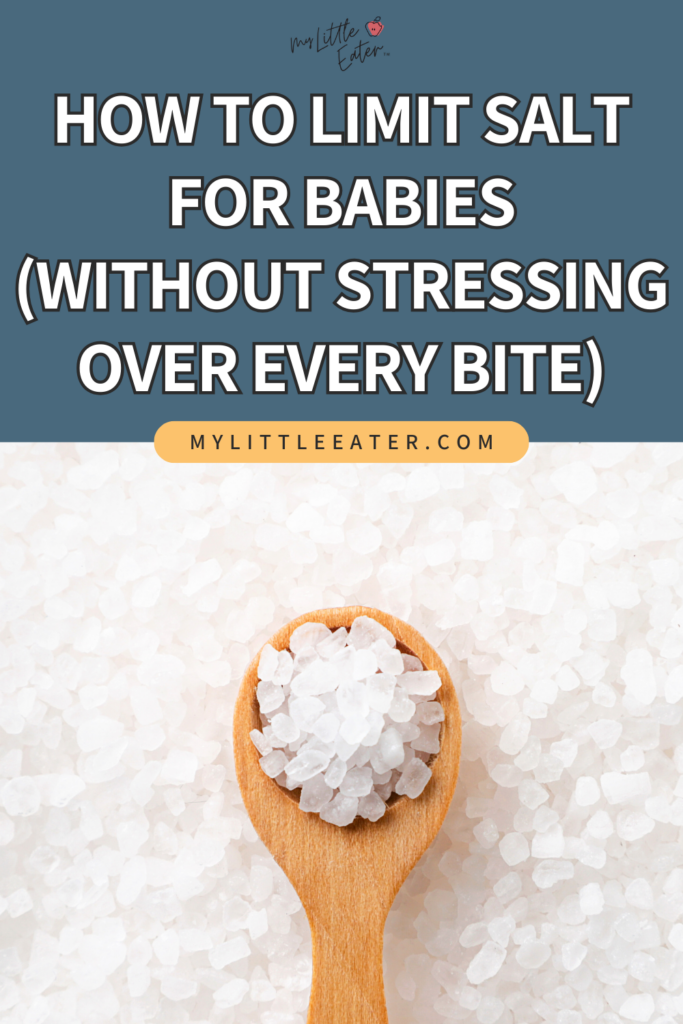
References
- Centers for Disease Control and Prevention. (2024). Salt: about sodium and health. https://www.cdc.gov/salt/about/index.html
- U.S. Department of Agriculture. (2019). Salt, table. https://fdc.nal.usda.gov/fdc-app.html#/food-details/173468/nutrients
- Mente, A., O’Donnell, M., & Yusuf, S. (2021). Sodium Intake and Health: What Should We Recommend Based on the Current Evidence?. Nutrients, 13(9), 3232. https://doi.org/10.3390/nu13093232
- Government of Canada. (2022). Sodium: sodium and your health. https://www.canada.ca/en/health-canada/services/nutrients/sodium.html
- U.S. Department of Agriculture. (2019). Beets, cooked, boiled, drained.https://fdc.nal.usda.gov/fdc-app.html#/food-details/169146/nutrients
- U.S. Department of Agriculture. (2019). Sweet potato, cooked, baked in skin, flesh, without salt. https://fdc.nal.usda.gov/fdc-app.html#/food-details/168483/nutrients
- U.S. Department of Agriculture. (2019). Carrots, raw. https://fdc.nal.usda.gov/fdc-app.html#/food-details/170393/nutrients
- U.S. Department of Agriculture. (2019). Avocados, raw, all commercial varieties. https://fdc.nal.usda.gov/fdc-app.html#/food-details/171705/nutrients
- U.S. Department of Agriculture. (2019). Melons, cantaloupe, raw. https://fdc.nal.usda.gov/fdc-app.html#/food-details/169092/nutrients
- U.S. Department of Agriculture. (2019). Apples, raw, with skin (Includes foods for USDA’s Food Distribution Program). https://fdc.nal.usda.gov/fdc-app.html#/food-details/171688/nutrients
- World Health Organization. (2020). Healthy diet. https://www.who.int/news-room/fact-sheets/detail/healthy-diet
- Corrêa Rezende, J. L., de Medeiros Frazão Duarte, M. C., Melo, G. R. D. A. E., Dos Santos, L. C., & Toral, N. (2022). Food-based dietary guidelines for children and adolescents. Frontiers in public health, 10, 1033580. https://doi.org/10.3389/fpubh.2022.1033580
- National Academies of Sciences, Engineering, and Medicine; Health and Medicine Division; Food and Nutrition Board; Committee to Review the Dietary Reference Intakes for Sodium and Potassium, Oria, M., Harrison, M., & Stallings, V. A. (Eds.). (2019). Dietary Reference Intakes for Sodium and Potassium. National Academies Press (US).
- U.S. Department of Agriculture. (2019). Cheese, cheddar. https://fdc.nal.usda.gov/food-details/328637/nutrients
- Institute of Medicine (US) Food and Nutrition Board. (1998). Dietary Reference Intakes: A Risk Assessment Model for Establishing Upper Intake Levels for Nutrients. National Academies Press (US).
- Gowrishankar, M., Blair, B., & Rieder, M. J. (2020). Dietary intake of sodium by children: Why it matters. Paediatrics & child health, 25(1), 47–61. https://doi.org/10.1093/pch/pxz153
- Institute of Medicine. 2007. Dietary Reference Intakes Research Synthesis: Workshop Summary. Washington, DC: The National Academies Press. https://doi.org/10.17226/11767.
- Andreas, N. J., Kampmann, B., & Le-Doare, K. M. (2015). Human breast milk: A review on its composition and bioactivity. Early human development, 91(11), 629-635.
- Aumeistere, L., Ciprovica, I., Zavadska, D., Bavrins, K., & Borisova, A.. (2020). Relation Between Human Milk Sodium and Maternal Sodium Intake. Proceedings of the Latvian Academy of Sciences Section B Natural Exact and Applied Sciences, 74(4), 232-236. 10.2478/prolas-2020-0037
- U.S. Food & Drug Administration. (2024). Sodium in Your Diet: use the nutrition facts label and reduce your intake. https://www.fda.gov/food/nutrition-education-resources-materials/sodium-your-diet
- Maalouf, J., Cogswell, M. E., Yuan, K., Martin, C., Gunn, J. P., Pehrsson, P., Merritt, R., & Bowman, B. (2015). Top sources of dietary sodium from birth to age 24 mo, United States, 2003-2010. The American journal of clinical nutrition, 101(5), 1021–1028. https://doi.org/10.3945/ajcn.114.099770
- Government of Canada. (2022). Sodium: Sodium and your health. https://www.canada.ca/en/health-canada/services/nutrients/sodium.html
- Government of Canada. (2024). Raw or unpasteurized milk. https://www.canada.ca/en/health-canada/services/milk-infant-formula/raw-or-unpasteurized-milk.html#
- Yang, S., & Wang, H. (2023). Avoidance of added salt for 6–12-month-old infants: A narrative review. Archives de Pédiatrie, 30(8), 595-599. https://doi.org/10.1016/j.arcped.2023.08.009.
- Simonetti, G. D., Raio, L., Surbek, D., Nelle, M., Frey, F. J., & Mohaupt, M. G. (2008). Salt sensitivity of children with low birth weight. Hypertension (Dallas, Tex. : 1979), 52(4), 625–630.
- Hofman, A., Hazebroek, A., & Valkenburg, H. A. (1983). A randomized trial of sodium intake and blood pressure in newborn infants. Jama, 250(3), 370-373.
- Geleijnse, J. M., Hofman, A., Witteman, J. C., Hazebroek, A. A., Valkenburg, H. A., & Grobbee, D. E. (1997). Long-term effects of neonatal sodium restriction on blood pressure. Hypertension, 29(4), 913-917.
- Fleischer Michaelsen, K., Weaver, L., Branca, F., & Robertson, A. (2003). Feeding and nutrition of infants and young children: Guidelines for the WHO European region, with emphasis on the former Soviet countries. WHO Regional Publications, WHO, European Series, No. 87.
- Modi, N. (1998). Hyponatraemia in the newborn. Archives of Disease in Childhood-Fetal and Neonatal Edition, 78(2), F81-F84.
- Durrani, N. U. R., Imam, A. A., & Soni, N. (2022). Hypernatremia in Newborns: A Practical Approach to Management. Biomedicine hub, 7(2), 55–69. https://doi.org/10.1159/000524637
- Gawlowski, Z., Aladangady, N., & Coen, P. G. (2006). Hypernatraemia in preterm infants born at less than 27 weeks gestation. Journal of paediatrics and child health, 42(12), 771–774. https://doi.org/10.1111/j.1440-1754.2006.00975.x
- Liem D. G. (2017). Infants’ and Children’s Salt Taste Perception and Liking: A Review. Nutrients, 9(9), 1011. https://doi.org/10.3390/nu9091011
- McCarron D. A. (2013). Physiology, not policy, drives sodium intake. American journal of hypertension, 26(10), 1191–1193. https://doi.org/10.1093/ajh/hpt151
- Government of Canada. (2023). Dietary reference intakes tables: Reference values for elements. https://www.canada.ca/en/health-canada/services/food-nutrition/healthy-eating/dietary-reference-intakes/tables/reference-values-elements.html
- Fayet-Moore, F., Wibisono, C., Carr, P., Duve, E., Petocz, P., Lancaster, G., McMillan, J., Marshall, S., & Blumfield, M. (2020). An Analysis of the Mineral Composition of Pink Salt Available in Australia. Foods (Basel, Switzerland), 9(10), 1490. https://doi.org/10.3390/foods9101490
- U.S. Department of Agriculture. (2019). Leavening agents, baking soda. https://fdc.nal.usda.gov/fdc-app.html#/food-details/175040/nutrients

Bianca Gruenewald, RD
Bianca is a Registered Dietitian and works in a client support role at My Little Eater Inc. She's a proud auntie to her three year old niece and four year old nephew!

Bianca Gruenewald, RD
Bianca is a Registered Dietitian and works in a client support role at My Little Eater Inc. She's a proud auntie to her three year old niece and four year old nephew!
 1 day only sale! 20% off with code FLASH20 at checkout
1 day only sale! 20% off with code FLASH20 at checkout 








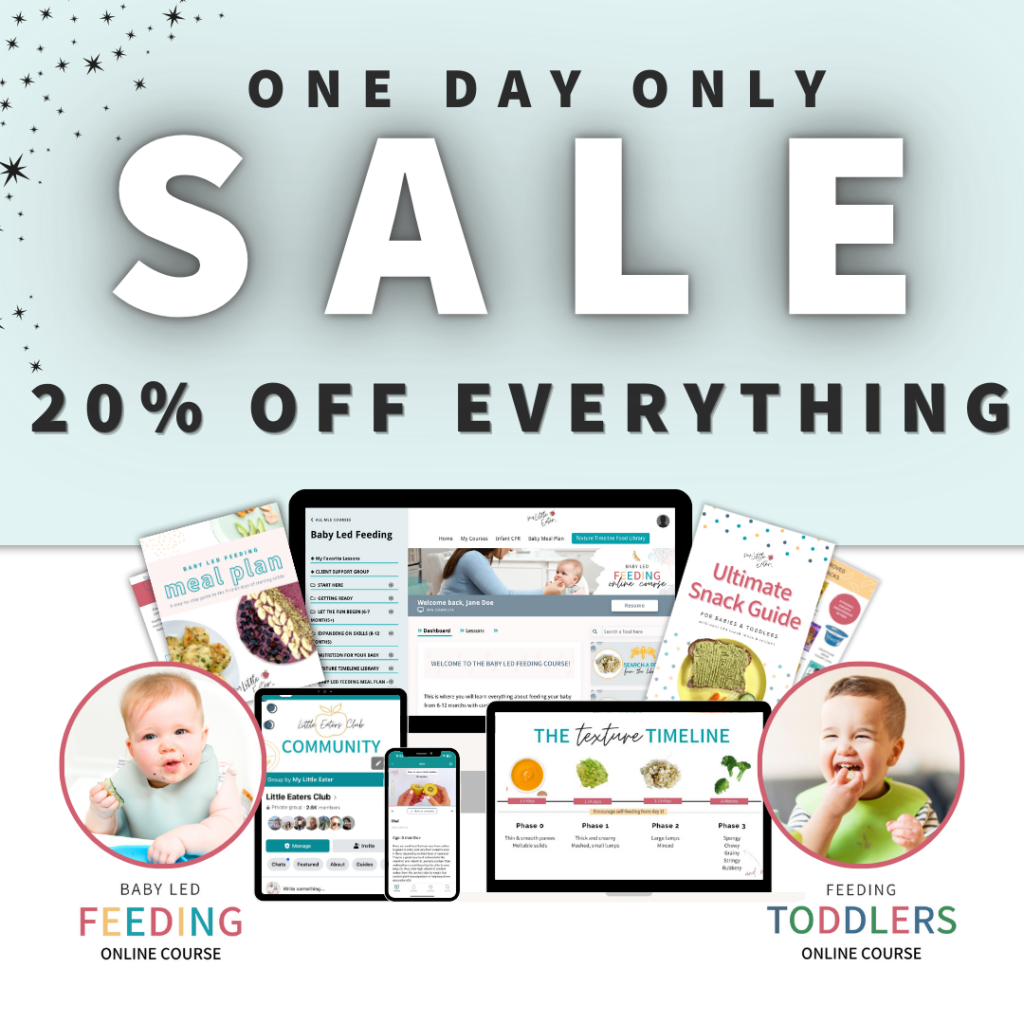
4 Comments
Thank you for this article! As a parent to a 1 year old, with some people saying to start salt and some saying to wait, this in-depth article was very helpful.
So glad it helped!
Thanks for the article! I would be so stressed about salt in the food for my first born. Now I can rest assured a little bit is going to be ok.
Hi Jennifer! So happy to hear that you enjoyed the blog and found it helpful! 🙂